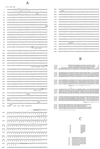IntI2 integron integrase in Tn7
- PMID: 11872723
- PMCID: PMC134885
- DOI: 10.1128/JB.184.6.1712-1721.2002
IntI2 integron integrase in Tn7
Abstract
Integrons can insert and excise antibiotic resistance genes on plasmids in bacteria by site-specific recombination. Class 1 integrons code for an integrase, IntI1 (337 amino acids in length), and are generally borne on elements derived from Tn5090, such as that found in the central part of Tn21. A second class of integron is found on transposon Tn7 and its relatives. We have completed the sequence of the Tn7 integrase gene, intI2, which contains an internal stop codon. This codon was found to be conserved among intI2 genes on three other Tn7-like transposons harboring different cassettes. The predicted peptide sequence (IntI2*) is 325 amino acids long and is 46% identical to IntI1. In order to detect recombination activity, the internal stop codon at position 179 in the parental allele was changed to a triplet coding for glutamic acid. The sequences flanking the cassette arrays in the class 1 and 2 integrons are not closely related, but a common pool of mobile cassettes is used by the different integron classes; two of the three antibiotic resistance cassettes on Tn7 and its close relatives are also found in various class 1 integrons. We also observed a fourth excisable cassette downstream of those described previously in Tn7. The fourth cassette encodes a 165-amino-acid protein of unknown function with 6.5 contiguous repeats of a sequence coding for 7 amino acids. IntI2*179E promoted site-specific excision of each of the cassettes in Tn7 at different frequencies. The integrases from Tn21 and Tn7 showed limited cross-specificity in that IntI1 could excise all cassettes from both Tn21 and Tn7. However, we did not observe a corresponding excision of the aadA1 cassette from Tn21 by IntI2*179E.
Figures




Similar articles
-
Transposon Tn5090 of plasmid R751, which carries an integron, is related to Tn7, Mu, and the retroelements.J Bacteriol. 1994 Jun;176(11):3257-68. doi: 10.1128/jb.176.11.3257-3268.1994. J Bacteriol. 1994. PMID: 8195081 Free PMC article.
-
Effect of attC structure on cassette excision by integron integrases.Mob DNA. 2011 Feb 18;2(1):3. doi: 10.1186/1759-8753-2-3. Mob DNA. 2011. PMID: 21332975 Free PMC article.
-
Characterization of the class 3 integron and the site-specific recombination system it determines.J Bacteriol. 2002 Jun;184(11):3017-26. doi: 10.1128/JB.184.11.3017-3026.2002. J Bacteriol. 2002. PMID: 12003943 Free PMC article.
-
[Integrons: gene collectors].Rev Argent Microbiol. 2010 Jan-Feb;42(1):63-78. doi: 10.1590/S0325-75412010000100014. Rev Argent Microbiol. 2010. PMID: 20461298 Review. Spanish.
-
Mobile gene cassettes and integrons: capture and spread of genes by site-specific recombination.Mol Microbiol. 1995 Feb;15(4):593-600. doi: 10.1111/j.1365-2958.1995.tb02368.x. Mol Microbiol. 1995. PMID: 7783631 Review.
Cited by
-
Integron involvement in environmental spread of antibiotic resistance.Front Microbiol. 2012 Apr 9;3:119. doi: 10.3389/fmicb.2012.00119. eCollection 2012. Front Microbiol. 2012. PMID: 22509175 Free PMC article.
-
Antimicrobial resistance markers of class 1 and class 2 integron-bearing Escherichia coli from irrigation water and sediments.Emerg Infect Dis. 2003 Jul;9(7):822-6. doi: 10.3201/eid0907.020529. Emerg Infect Dis. 2003. PMID: 12890322 Free PMC article.
-
High genetic stability of integrons in clinical isolates of Shigella spp. of worldwide origin.Antimicrob Agents Chemother. 2007 Apr;51(4):1333-40. doi: 10.1128/AAC.01109-06. Epub 2007 Jan 22. Antimicrob Agents Chemother. 2007. PMID: 17242143 Free PMC article.
-
Sequence analysis of the mobile genome island pKLC102 of Pseudomonas aeruginosa C.J Bacteriol. 2004 Jan;186(2):518-34. doi: 10.1128/JB.186.2.518-534.2004. J Bacteriol. 2004. PMID: 14702321 Free PMC article.
-
Four novel resistance integron gene-cassette occurrences in bacterial isolates from zhenjiang, china.Curr Microbiol. 2009 Aug;59(2):113-7. doi: 10.1007/s00284-009-9405-z. Epub 2009 Apr 14. Curr Microbiol. 2009. PMID: 19365688
References
-
- Arcisczewska, L. K., R. L. McKown, and N. L. Craig. 1991. Purification of TnsB, a transposition protein that binds to the ends of Tn7. J. Biol. Chem. 266:21736-21744. - PubMed
-
- Argos, P., A. Landy, K. Abremski, J. B. Egan, E. Haggård-Ljungquist, R. H. Hoess, M. L. Kahn, B. Kalionis, S. V. L. Narayana, L. S. Pierson, N. Sternberg, and J. M. Leong. 1986. The integrase family of site-specific recombinases: regional similarities and global diversity. EMBO J. 5:433-440. - PMC - PubMed
-
- Bartolomé, B., Y. Jubete, E. Martinez, and F. de la Cruz. 1991. Construction and properties of a family of pACYC-derived cloning vectors compatible with pBR322 and its derivatives. Gene 102:75-78. - PubMed
Publication types
MeSH terms
Substances
Associated data
- Actions
- Actions
LinkOut - more resources
Full Text Sources

